[ad_1]
There’s more to ecommerce customer acquisition than increasing checkout conversion rates. For long-term, sustainable success, you must attract the right customers.
The key is ongoing measurement and testing to understand which acquisition strategies work for your ecommerce business.
In this article, you’ll learn how to gauge the effectiveness of any customer acquisition strategy. Find and fix leaks in your current acquisition strategy, and acquire high-value customers efficiently, so you can grow faster than the competition.
What is customer acquisition, and how does it support growth?
Customer acquisition is the process of finding best-fit customers and persuading them to buy from your ecommerce business in a measurable and repeatable way.
You can break it down into three broad stages:
- Lead generation (attracting leads toward your business)
- Nurturing those leads toward buying decisions (engaging those leads through your content)
- Converting them into customers (convincing them to buy)
But there’s a fourth stage that often goes unconsidered. By meeting buyers’ post-purchase needs, you’ll improve customer retention. You’ll also maximize return on investment (ROI) and reduce overall average customer acquisition costs (CAC).
Acquiring more of your ideal customers will lead to profitable relationships because customers will want to buy from you multiple times.
It’s also the first step of a broader customer experience. From start to finish, that experience ideally follows this path:
- Leads or subscribers. This is when your ideal customer shows interest.
- Customers. Your leads have decided you’re the solution and buy for the first time
- Referrals. They’ve bought your product multiple times and are ready to tell others.
- Advocates. They’re customers for life who market your business for you (e.g., by posting about it on social media).
What makes customer acquisition different from marketing?
Where marketing drives brand awareness, customer acquisition drives conversions and sales to generate revenue. Customer acquisition is concerned with the actions taken to nurture customers towards a purchase, like emailing a coupon or showing targeted ads (e.g., Google ads).
These actions might happen immediately or months later, but the purpose is always to convert visitors into customers.
Get it right: Good vs. bad customer acquisition examples
Data-driven strategies focused on ROI over revenue win the customer acquisition game.
Here’s an example to illustrate the difference.
Scenario 1: The D2C haircare brand
A direct-to-customer haircare brand runs an email marketing campaign with a coupon for 10% off for new customers. The email achieves a 20% open rate, drives brand awareness, and results in 800 new customers.
One month later, sales are up by $38,500, and the business owner deems the campaign a success.
However, the business owner paid a consultant for the strategy, $1,500 for the email list, $225 for the email template, and $200 for the copy. They got an ROI of $2 on every $1 spent.
Why such a poor return?
- The email list recipients weren’t the business’s target audience;
- Because of this, many had a negative buying experience;
- Half wrote negative reviews or warned friends to avoid the brand.
No new customers made a second purchase and the company’s reputation suffered, reducing sales to below average for three months.
Scenario 2: The online fashion retailer
Conversely, a high-end fashion ecommerce store runs Facebook Ads. It repurposes existing copy and creative, and it retargets website visitors and social followers.
One month later, these ads generated 175 click-throughs and 20 sales at a cost-per-click of $0.70. The marketing cost for the campaign totaled $122.50.
Although the campaign only generated 20 new customers, they each spent an average of $150 on products, generating $3,000 in revenue.
These ICPs (ideal customer profiles, i.e. your best customers) had satisfying experiences and appreciated personalized post-purchase emails suggesting other products similar to their recent purchase. Fifteen wrote positive reviews, and eight made second purchases within three months.
What separates these business examples?
The online fashion retailer pulled in fewer customers and generated a fraction of the revenue.
Yet, it was better at customer acquisition for three reasons:
- Marketing efficiency. The retailer invested in a data-driven campaign, resulting in lower ad spend and a higher ROI.
- Data-driven targeting. It used demographic and website data to target shoppers who were likely to spend more and be satisfied with their orders.
- Post-purchase experience. It followed up post-conversion to ensure buyers were happy, improving the overall customer experience to generate repeat business and brand advocacy.
Bad customer acquisition strategies can cause your business to fall behind more efficient competitors. If you keep spending $1 to make $2, a competing business that makes $4 on the same investment will grow faster than you.
Misaligned targeting is expensive and often drives poor experiences and conversion.
Outlier converts may spend money but are unlikely to become brand advocates or repeat customers. You’ll need to replace one-time buyers with a number of new customers by restarting the acquisition process.
Measuring customer acquisition for peak effectiveness
Basic metrics like deals completed and revenue generated don’t measure customer acquisition success.
Combine CAC and LTV (lifetime value), which go beyond sales to measure acquisition efficiency and value, for a clearer picture.
How to calculate ecommerce customer acquisition cost
CAC is the key to preventing reckless spending. Calculate it with the following formula:
Total spend on acquiring customers / Number of customers acquired
Let’s define those terms.
Number of customers acquired
Use total first-time purchasers for the easiest “Number of customers acquired” calculation or include returning customers for a fuller picture.
Returning after how long? That’s up to you, but keep it consistent for all your calculations moving forward.
For example, for an online guitar strings store, a buyer who takes three years to make their second purchase might as well be a new customer. For a company selling high-ticket products, like cars, the same purchase frequency indicates repeat business instead.
Segment repeat customers and look at their purchase frequency. Draw a line above the highest average time between orders to use as a threshold.
The threshold is clearer for subscription businesses: a returning customer is someone who restarts a subscription (creating fresh monthly recurring revenue, or MRR) after churning.
Be sure to also account for product prices and customer lifespans when assessing your data.
Total spend on acquiring customers
“Total spend on acquiring customers” is ambiguous, but in most cases, you can include:
- Sales and marketing team salaries;
- Advertising spend on acquiring new customers;
- Sales and marketing hardware and software costs;
- Agency, PR, and other outsourced sales and digital marketing spend.
The total of these costs divided by total new customers gives you CAC.
Here’s how this could look for Business A over three months:
In February, for example, CAC is:
$33,000 / 1200 = $28
The calculation is more complex for products with free trials, starter promotions, and freemium models as there are longer delays between acquisition spending and customer conversion.
We explored those scenarios in an article on how to calculate and maintain healthy CACs.
Account for return customers by including the cost of re-engagement campaigns in your acquisition total. For more accurate data, calculate CAC separately for new and returning customers.
Calculate much your customers are worth: LTV
A customer who pays $100 for one product is less valuable than a subscriber who pays $100 weekly for a year. However, CAC treats them equally if they both convert from the same marketing effort.
Divide LTV by CAC for a ratio that more accurately gauges customer acquisition effectiveness.
Customer Lifetime Value (LTV) refers to the total revenue you expect a customer to generate during their stay with your business. There are several ways to calculate it, but here’s a basic formula:
Average order value x Number of repeat transactions x Average retention time
In our earlier example, Business A’s CAC increased from $28 to $44 from February to March.
Without LTV for context, CAC suggests its customer acquisition strategy became less effective.
However, if we also saw that LTV increased by 57%, we’d know the company was attracting higher-value customers by spending more on customer acquisition. Anything above 57% would contribute to a higher LTV/CAC ratio, signaling greater profitability.
Below are some LTV/CAC ratio benchmarks for guidance:
- <1. You’re losing revenue on every customer.
- 1–2. Your customer acquisition strategy is inefficient. You’ll lose ground on the competition.
- 3–5. Ideal for a scaling business.
- 5+. Customer acquisition is going well. Re-invest in sales and marketing.
MRR, churn rates, and other factors that affect your LTV/CAC ratios
Most ecommerce businesses improve LTV by growing average purchase value, average purchase frequency, and customer retention rates.
Subscription businesses, like SaaS providers and some ecommerce platforms, should focus on reducing churn and increasing monthly recurring revenue, or MRR (the total recurring revenue a company generates from all subscription accounts normalized into a monthly amount).
The same three steps help all ecommerce businesses maximize LTV:
- Selling to ICPs using highly-targeted marketing campaigns, so buyers get the experience they expect;
- Optimizing the customer experience to build trust;
- Upselling and cross-selling based on customer needs.
Nutrition brand Huel cross-sells at the checkout to grow MRR for subscription customers and average purchase value for one-time buyers.
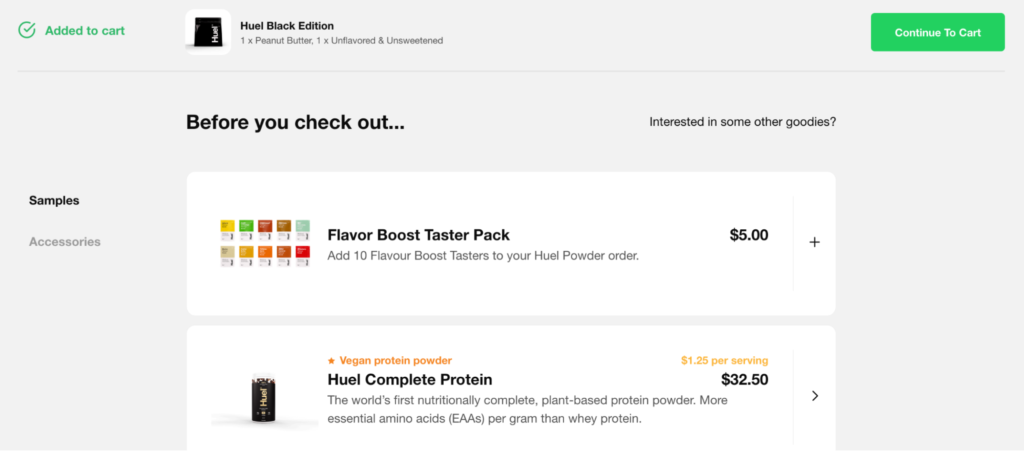
Find and fix customer acquisition funnel leaks
By continually measuring customer acquisition effectiveness, you can repeat successful actions to improve ROI.
Visualizing the process will help you identify and fix leaks (points at which prospects regularly disengage).
You’ll see plenty of customer acquisition funnels (or “marketing funnels”) that stop at conversion. To get a realistic picture of how your business is doing, you need to also account for customer retention.
Website analytics data and voice-of-customer (VoC) research show where and why shoppers fall out of your acquisition funnel.
Google Analytics helps you dig into where leaks occur. Edin Šabanović outlines how to spot trouble areas in this post on funnel analysis.
For example, if a Facebook ad drives 1,000 people to your site but Google Analytics shows the product landing page has an exit rate of 66%, it indicates visitors aren’t getting what they need at the consideration stage.
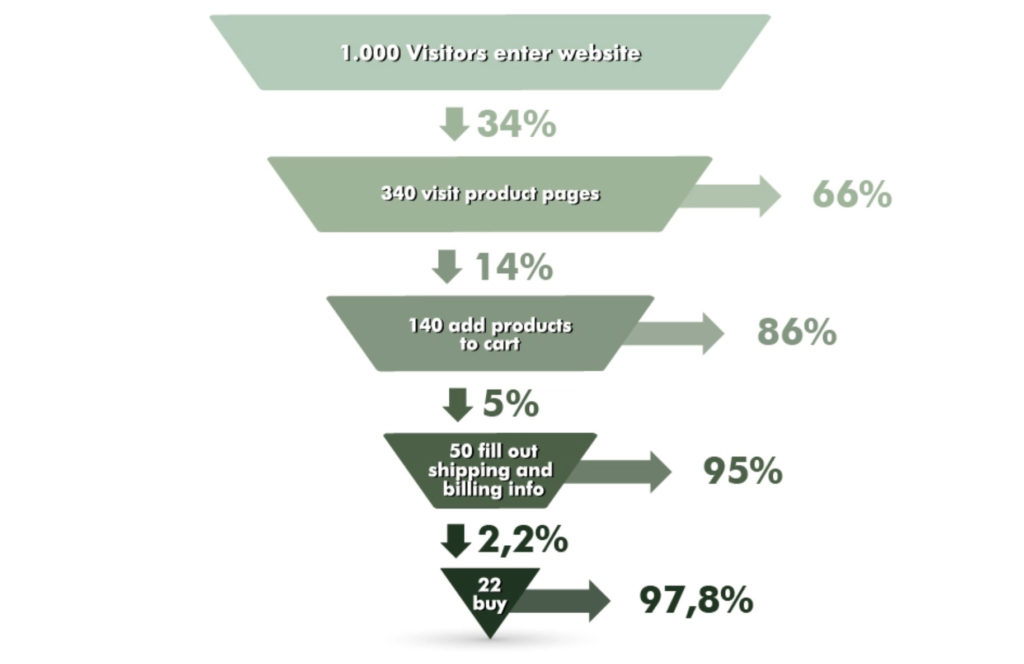
Given that 85% of shoppers told Google that product information and pictures contribute to their buying decisions, you could fix that consideration-stage leak by:
- Adding high-quality product images;
- Re-aligning benefit copy with ICP needs and pain points;
- Creating spec sheets to help prospects compare products easily.
Speak to prospects and customers for more “why” context.
Jennifer Havice suggests asking the following question when carrying out VoC research:
What concerns or hesitations did you have before you decided to buy/work with us?
Addressing sources of friction in your copy is incredibly important. You can reflect your customers’ concerns back to them, showing how you’ll alleviate them.
Ask existing customers this question to identify weaknesses in your acquisition process. For example, the customer you speak to may have persevered through a difficult checkout process but the same issue might stop dozens of others from buying.
Website visitors who don’t buy have equally valuable insight.
If multiple people give the same reason for walking away, it’s a funnel leak you need to fix. Get feedback easily using automated exit forms and chatbots, or send email surveys to catch people in the days after.
Be frank with your questions and honest about your motive. Multiple choice questions yield quantitative data but limited insight, as respondents could be forced to pick an answer that doesn’t reflect their feelings.
Open feedback boxes (qualitative surveys) allow for more detailed and subjective responses, but these aren’t directly comparable, so they’re unhelpful for quickly measuring change. Use both question formats for an accurate picture.
5 customer acquisition strategies to increase sales and loyalty (with examples)
It takes a range of content to build a solid customer acquisition funnel.
Gareth Hancock dives deep into the types that work and when in this guide on building marketing funnels.
Here are five tried-and-tested acquisition strategies to bolster your strategy.
1. Create awareness with paid social media posts
Digital ad spending in the U.S. increased 57% between 2020 and 2022 and Insider Intelligence expects it to grow another 30% by 2025.
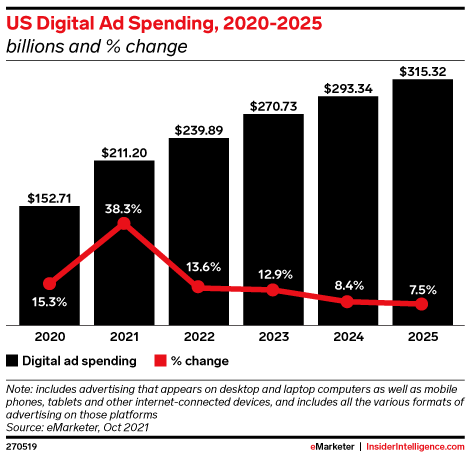
Facebook, Instagram, and TikTok are generally stronger B2C plays, while LinkedIn is better suited to B2B. Leverage the platforms where your audience spends the most time.
Of Instagram’s 1.5 billion+ users, 90% follow at least one business account, and 50% are more interested in a brand when they see ads for it in their feeds. This makes the platform great for building brand awareness.
For example, D2C haircare brand Prose achieved a 52% higher unique audience reach and reduced its CAC by 23% using a mix of organic and sponsored Reels on Instagram.

To maximize reach and engagement, use up-to-date buyer personas to set appropriate targeting parameters in Ads Manager (for Facebook and Instagram).
Prose showed its ads to a broad audience of U.S. adults. It excluded existing members and recent purchasers to achieve a higher unique audience reach and grow brand awareness.
Snappy mobile-friendly videos are proven to get more engagement than other content formats. One HubSpot survey found that 62% of people consume online videos thoroughly but are more likely to skim photos, audio, and written content.
The three most effective types of social media content are:
- Funny content. TikTok is an especially light-hearted, creative environment, but Instagram works too. Use them to make your audience laugh with short videos.
- Interactive content. Quizzes, polls, and contests allow followers to join your community.
- Authentic (or “behind-the-scenes”) content. Honest, transparent messaging closes the business-consumer divide to make your brand more relatable.
2. Build high-value customer relationships with helpful organic social content
Where ads grab attention, organic social content keeps followers engaged.
Use a range of content formats and themes to build rapport. The more followers think about and trust your brand, the more likely they are to buy and advocate for its products.
When creating social media content, aim to trigger emotional responses from your audience by:
- Posting relatable content;
- Helping them overcome challenges;
- Providing helpful information about your business and its products.
Education app Headway knows its followers care about personal growth. Instead of pushing products, the company offers advice that helps followers overcome challenges. This book recommendation post got close to 1,200 likes:
Headway’s post was successful (in the context of its other posts) for three reasons:
- It uses an eye-catching title image with bright colors and bold simple text;
- It has multiple slides, encouraging followers to learn more rather than scroll past;
- It appeals to its audience’s interest in self-development.
Music accessories retailer Ernie Ball highlights product value with an attractive and relatable image in this Facebook post. It includes a product link to generate online store traffic, but the post isn’t overtly sales-focused.
The brand immediately highlights an audience pain point (“limited space at your studio?”) and uses a relatable reference to another, more established product (“smaller than a pack of Slinkys”) to highlight a benefit of its power supply.
The image also contains elements most followers will recognize (a guitar resting on a studio floor with multiple cables). The only unfamiliar part is the subtly placed new product, which eventually draws the user’s attention.
3. Borrow trust for fast results with influencer marketing
Influencer marketing can give something other acquisition channels can’t: instant trust.
A recent Oracle study found that 37% of consumers trust social media influencers over brands.
And you don’t need a user with millions of followers to get results. HypeAuditor’s State of Influencer Marketing 2021 report shows that nano-influencers (those with 1–5k followers) get over three times more engagement than mega-influencers (1M+ followers).
These nano-influencers have more opportunities to interact with and learn about their followers. They know what their audiences value and can inject that into marketing content to increase engagement.
The most popular platforms for influencer marketing are Instagram and TikTok (the latter is growing rapidly, particularly among users aged 16–25).
Look for nano-influencers on these platforms who have strong relationships with your target market. These are realistic collaborators who can add human touches to your messaging.
REN Skincare worked with beauty influencers on TikTok to raise brand awareness and drive conversions for one of its products. One of the clips attracted 140.6K likes despite REN Skincare having only 26.4K followers.
Despite REN Skincare paying for the placement, the content feels like an authentic customer review. The influencer uses the trust they’ve built up over time to personally recommend the ecommerce brand’s product to their large, already-engaged audience.
4. Personalize the buyer journey with email marketing
A HubSpot survey found personalization to be the most effective email marketing strategy.
Every organically-obtained email address is a direct line to a consenting prospect. Use email to nurture recipients to conversion and beyond with relevant information and buying incentives.
Running brand On uses personalized emails to tackle cart abandonment:
The subject line “still available?” speaks to the shopper’s browsing history and leverages urgency to entice them into completing a purchase.
This sequence is likely part of an automated drip campaign that reduces CAC.
Emails are particularly effective around the conversion stage. According to Google, 49% of shoppers think their shopping experience would be better if retailers offered promotions or deals specific to past purchases. Convert hesitant prospects, increase repeat transactions or cross-sell by sending relevant offers.
5. Get seen with SEO-driven content marketing
People trust Google to prioritize the most relevant information in search results. Showing up first for relevant terms will get you seen by high-value leads.
HubSpot research shows search engine optimization (SEO) as the second most effective marketing channel for acquiring new customers (behind social media), with organic search driving 17% of survey respondents’ web traffic.
Original, helpful content still rules the SERPs.
Search engines prioritize the most helpful and original content when ordering results, as this gives users the best experience. Align your content topics and formats with your audience’s pain points and interests to increase your chances of reaching and staying on page one.
Be realistic. You’ll never outrank dictionary.com and international mega-brands for keywords like “clothes,” so go for specificity.
MagicLinen, a brand with only 312 Twitter followers, outranks multi-billion-dollar retailer Nordstrom for the phrase “linen clothing for women.”
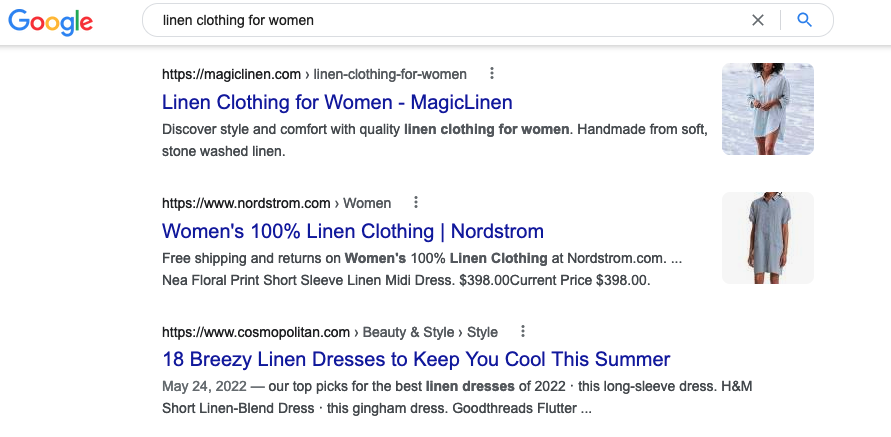
Here are Google’s reasons for bringing up MagicLinen’s website first:
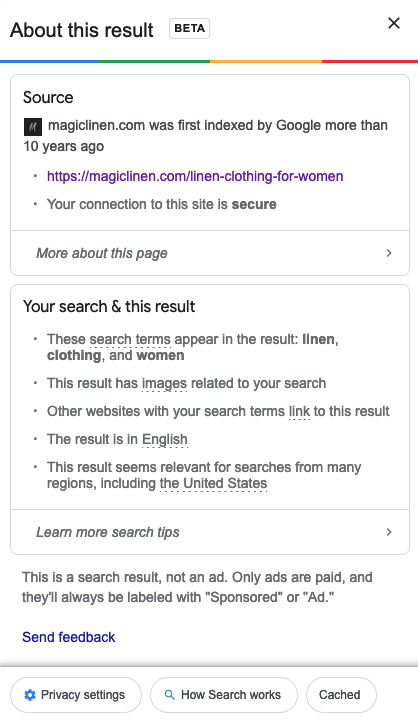
Under the “Your search & this result” header, Google tells us:
- All three search terms appear on that page (“linen, clothing, and women”);
- The page contains search-relevant images;
- Other websites on this topic link to this page;
- The result uses the searcher’s language.
These are all fundamental (and basic) content SEO practices but, by doing these well, plus a plethora of other important SEO factors that Google doesn’t mention in detail, MagicLinen outranks a major competitor and is likely to get more clicks from high-value customers as a result.
Blogs that answer audience questions can also push you up the SERPs, even if those questions aren’t directly product-related.
Juice retailer Press covers audience-relevant topics and ranks on page one of Google for terms like “digital detox retreats 2022” and “veganuary environmental impact.”
While people who search these terms aren’t explicitly looking for pressed juice, their interest in detoxing, veganism, and the environment suggests they’re part of Press’s target market.
As well as bringing ICPs to Press’ website to learn more about products, these blogs show potential customers that the brand shares their interests. That relatability contributes to trust, which in turn helps people make buying decisions.
Conclusion
Value and efficiency separate good customer acquisition from bad. Optimizing LTV and CAC is how ecommerce’s most successful businesses outperform their competitors.
But there’s no golden strategy for customer acquisition. It takes a balanced mix of data-informed tactics to reach high-value leads, convert them, and build loyalty.
Become great at customer acquisition and grow your ecommerce business with CXL’s Ecommerce Marketing Minidegree.
[ad_2]
Source link









